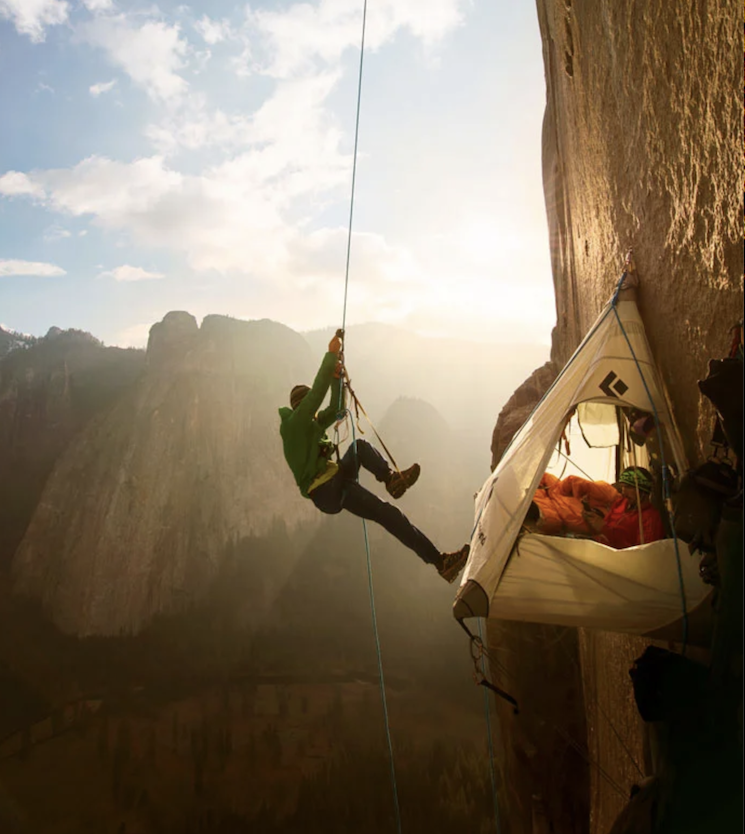
Room with a View. Tommy Caldwell hangs from a rope while Kevin Jorgeson relaxes in a tent while climbing El Capitan’s Dawn Wall in Yosemite National Park. Photo by Corey Rich
By Matt Johanson
They had been climbing for three days, traversing upward across the stony face of the mountain, when an icy winter storm rolled through Yosemite Valley. Their bivouac for the night was high above on a narrow ledge. Getting there meant hoisting themselves between bolts and pitons pounded into the granite by earlier climbers. A waterfall of melting snow would soon provide a bonus challenge.
For Errett Allen and Mike Corbett, two outdoorsmen determined to reach the top of Yosemite’s El Capitan in winter, the perils were just beginning.
Wind increased through the night and by the next day an icy rain threatened both men with hypothermia, Allen remembers. After climbing a pitch, “I found Mike shivering uncontrollably and fumbling in the bags for our rain gear,” Allen said.
After they hastily set up a hanging shelter beneath a rocky outcropping, “we discovered that all of our bivvy gear was soaking wet! We had been careless about packing it that morning.”
Icy Bivouac, Frigid Feet
As the sun set and temperatures dropped even more, they found their sleeping bags and jackets were no longer wet. “They were now frozen lumps of ice, completely useless,” Allen said. “That night was the longest and coldest bivouac of my life. With nothing but our wool to keep us from freezing, we spent the whole night rubbing what little warmth we could into our hands, feet and limbs. Sleep was impossible.”
Climbing El Cap fulfills lifelong dreams. Rock climbers yearn to jam their hands and feet into granite cracks as they ascend towering walls. If confronted with steep, featureless rock, climbers sometimes anchor their ropes to bolts, descend to the rope’s end and then run back and forth, swinging like a pendulum, to reach distant ledges.
But not everyone who attempts the 3,000-foot granite monolith succeeds. Allen and Corbett faced more difficulty than most when they attempted a route called New Dawn. The two had years of experience, 200 pounds of gear and a sunny forecast but still had to fight for their lives.
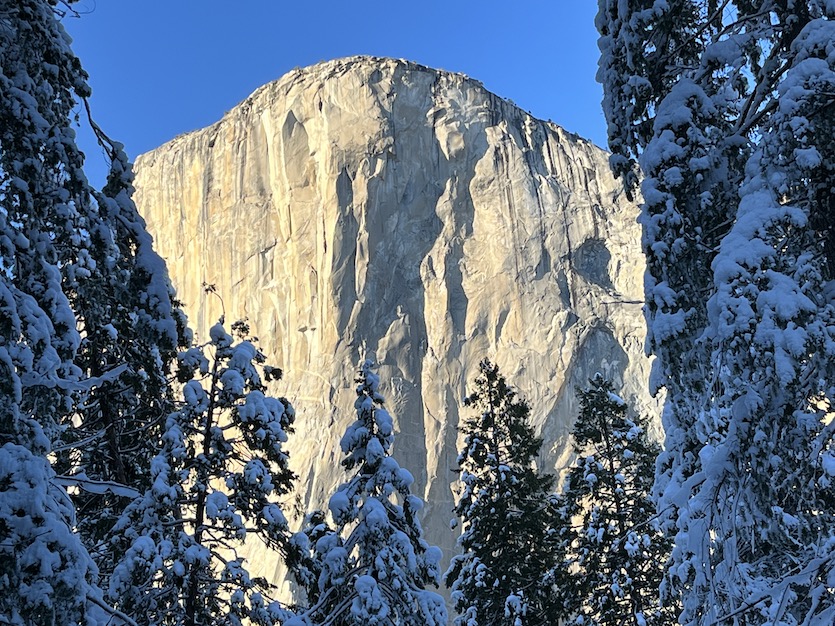
Winter conditions make climbing El Capitan even more challenging, as Errett Allen and Mike Corbett learned. Photo by Matt Johanson
By the morning of the seventh day, their food was almost all gone and the snowpack on the rim of El Cap was melting. “Blocks of ice four feet thick and as long as railroad boxcars began to peel off the rim,” Allen said. The ice blocks shot past the climbers making a terrifying swoosh sound. “They smashed into the wall with great force breaking into thousands of pieces which showered the forest below.”
Finally, they pulled themselves onto the summit on their eighth day. “Though tired, sore, hungry and weak, we were completely elated at having survived and accomplished our goal through so much adversity,” Allen said. All that remained was a final night in the freezing elements and an eight-mile descent hike through deep snow.
El Capitan Conquered
El Capitan has a way of dealing out unexpected challenges, as countless climbers will attest. In 1958, Warren Harding led a team that labored 47 days to achieve the first ascent of El Cap’s sheer face. A final push through a cold night brought the exhausted group to the summit on Nov. 12. “El Capitan Conquered,” cheered one newspaper, though Harding himself was more modest: “It was not at all clear to me who was conqueror and who was conquered… El Cap seemed to be in much better condition than I was.”
The pioneers named their new route The Nose, as it divides the mountain’s wide face vertically down the middle.
That breakthrough changed climbing forever. Through the 1960s, climbers flocked to Yosemite to establish new routes. Meanwhile, El Cap witnessed its first long falls, though the use of ropes, pitons and other equipment usually prevented injuries.
Some climbers focused on speed. In 1975, three climbers summited in just 15 hours, the first ascent in less than a day. Up to this point, big wall climbing involved pitons and what climbers call direct aid, which means pulling and standing on gear to assist in upward progress.
Free Climbing Ups The Ante
Then free climbing, in which climbers scale just the rock and use gear only to protect falls, came into vogue even on large objectives. Two climbers made El Cap’s first free ascent in 1988.
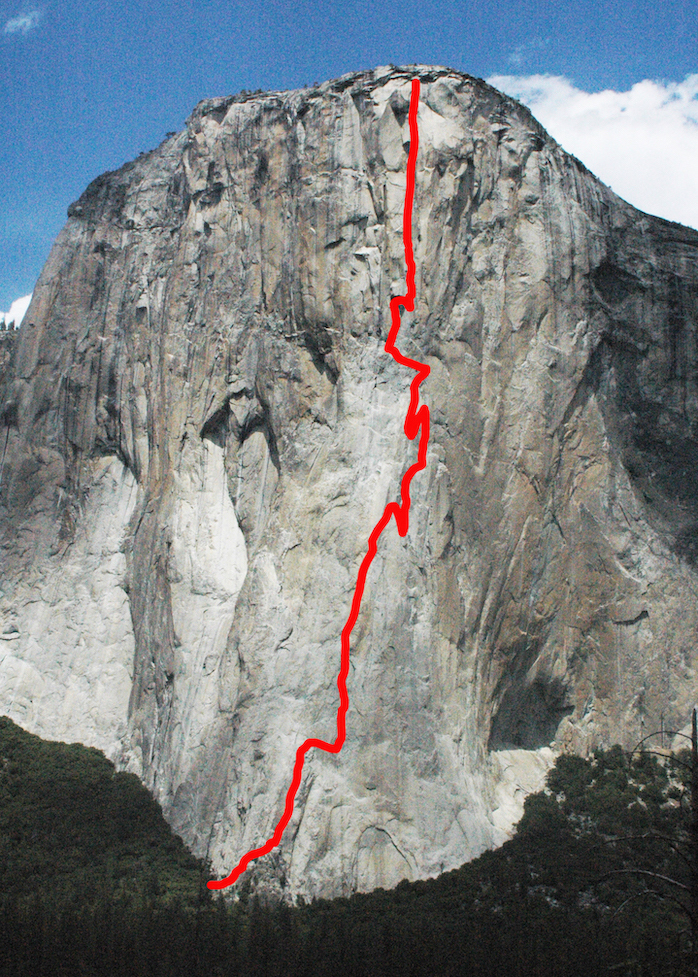
The Nose, El Capitan’s most popular route, runs down the middle of the mountain. Photo by Matt Johanson
Yet with these achievements came great loss. According to a Yosemite study of climbing from 1970 to 1990, 51 climbers died from traumatic injuries and four perished from hypothermia. At least 57 more would have perished without fast help from Yosemite Search and Rescue. More than 100 accidents caused at least 50 broken bones and a far greater number of sprains, cuts and bruises annually during that period.
By the 1990s, climbers were combining speed and free climbing. The Nose became ever more popular, as ascents increased from one every few years to multiple parties per day. The route’s excellent rock quality, scenery, ease of approach and historic significance make it perhaps the most coveted climb in the world.
Among the climbers who felt its pull were Noah Kaufman and Bernard Guest. “When I first arrived in the valley, my jaw dropped to my knees. It was way more impressive than anything I had seen up to that point in my life,” Kaufman said.
Finding El Capitan especially magnetic, Kaufman and Bernard set their sights on The Nose. A third climber also named Noah offered to join their team; he claimed to be an expert who had climbed the wall before. “Perfect!” Kaufman thought.
Like most groups, the three planned a multi-day effort and brought food, water and overnight gear in a haul bag, which climbers call a pig. By this era, climbers had mostly abandoned pitons, which mar rock over time. Instead, they placed less damaging forms of protection, like spring-loaded cams, in cracks for protection.
“We had a really fun day climbing the Stoveleg Cracks,” Kaufman said, referring to a popular section. “We were leapfrogging and taking turns leading. I learned how to jumar (to ascend a fixed rope) and the three of us were getting our systems down. The climbing was immaculate and world-class.”
Terror on Eagle Ledge
As the wall steepened, the team’s supposedly most-capable member seemed to falter. About halfway up the wall at a spot called Eagle Ledge, Noah began a moderate lead, protected himself with a cam in a crack, but seemed “scared and intimidated,” Kaufman said.
Then Noah fell. That should not have been a problem, as he was roped. But while leading, he scraped the rope against a sharp edge. His fall weighted the line against the knife-like granite and instantly broke it. For a heartbeat, Noah plunged toward certain doom. However, against all odds, he landed beside his teammates on tiny Eagle Ledge, just one foot wide, uninjured and even unaware of his improbable luck.
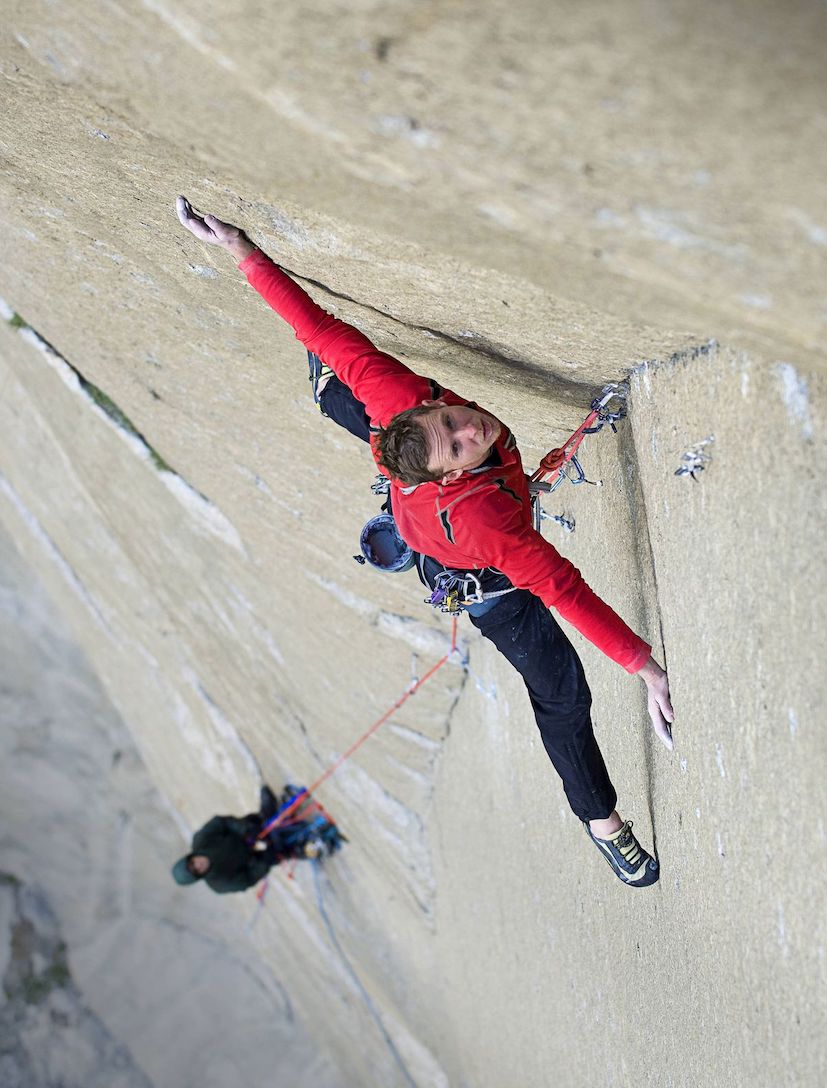
Tommy Caldwell labored seven years to ascend Dawn Wall. Photo by Corey Rich
Kaufman immediately secured his partner with a sling and carabiner. “We had this long moment of silence while we all visualized him falling a thousand feet and becoming a ketchup smear on the slabs below,” Kaufman said. “Noah’s shirt was off, and I could see his heart pounding as he put it together. Then he knelt at the belay and started sobbing.”
Traumatic as it was, the 1999 ordeal gave Kaufman more confidence and self-reliance. “That first big wall was the ultimate trial by fire for me, and I thought I’d never do another one, ever. The Nose was the craziest, most horrible, amazing, and way-too-intense experience I’d ever had. But of course, I went back, and I’ve done a bunch of big walls since. Now that I know what I’m doing, they’re a lot more fun.”
Big Walls On Big Screen
Achievement and danger both seemed to magnify in the last decade.
Tommy Caldwell and Kevin Jorgeson labored seven years to free climb El Cap’s absurdly-difficult Dawn Wall. The route’s crux (hardest section) is a horizontal traverse across rock with only the tiniest holds for fingers and toes, spaced far apart and sharp enough to draw blood when gripped. Caldwell and Jorgeson practiced this 15th pitch (a section of climbing about the length of one rope) hundreds of times before succeeding. The men’s final push up Dawn Wall triumphed over 19 days in 2015, drawing international attention and even a White House shout-out from President Barack Obama.
That was a tough act to follow, but in 2017, Alex Honnold answered with an even more unthinkable feat: El Capitan’s first and only free solo ascent. After years of preparation, he climbed the Freerider route without a partner, rope or any protective gear. Honnold’s self-imposed challenge required him to climb perfectly or die.
Those exploits gained exposure through the beautifully filmed “Dawn Wall” and “Free Solo” movies. By spending nearly as much time on the wall as the climbers, filmmakers gave the public its best look ever at big wall life. Climbing’s popularity grew even greater.
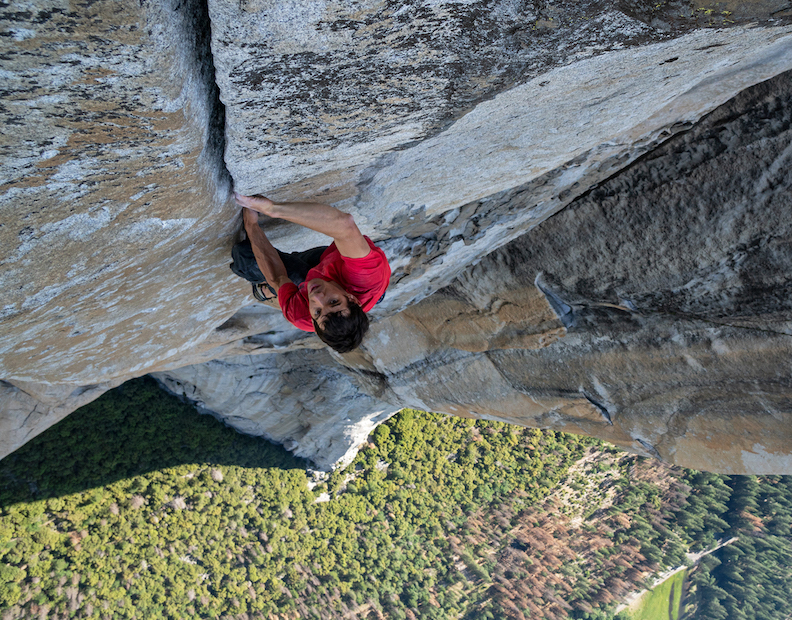
Alex Honnold completed El Capitan’s only ropeless ascent in 2017. National Geographic photo
For an encore, Caldwell and Honnold teamed up in 2018 to shatter The Nose speed record, sprinting up in a mind-boggling 1 hour and 58 minutes. Typically, climbers work in pairs, and one leads while the other remains anchored to manage the rope. But speed climbers ascend simultaneously, greatly increasing both their pace and danger. If either partner falls, the rope will probably pull the other down also. Caldwell and Honnold did not fall, and together set a record that may stand for a very long time.
Speed Comes at a Price
Increased interest in climbing and the dangerous techniques climbers adopted brought a rash of serious accidents. Since 2000, a dozen fatalities occurred on El Cap alone. An especially bad year was 2018 when one climber broke both legs, another broke her spine and two more fell to their deaths. All four were highly experienced, with hundreds of El Cap ascents between them.
Some sustain injuries or worse risks that threaten anyone even near the steep mountain. A party dropped a haul bag in 2016, breaking the arm of a climber below. Rockfall, described as “the size of an apartment building,” killed a climber and injured another in 2017. A fist-sized rock hit a climber sleeping in a hammock in 2021, fracturing his skull.
Yosemite estimates that 25,000 to 50,000 climber days annually result in about 100 accidents and 15-25 rescues. That would mean that more than 99 percent of climbs end without problems. Yet, 121 climbers died in the park since 1905, including 32 on El Capitan.
“Most climbers do a good job coping with the hazards of their sport,” writes ranger John Dill, a search and rescue veteran with more than 40 years of experience, in a well-read cautionary report called “Staying Alive.”
But climbers could and should reduce the accident rate, Dill wrote, by anticipating and preparing for the multiple dangers they could face. Wearing helmets, bringing enough water, carrying rain gear, studying descent routes, rappelling properly, and placing protective gear even on “easy” terrain are a few of his suggestions.
Cathie Yun and Julie Wang, who climbed The Nose in 2022, seemed to embrace the planning and caution Dill endorses. Before their attempt, they improved their fitness with months of training and practice runs on the wall’s bottom half. Then they scheduled their adventure for June, when favorable weather was likely. “We are team ‘safety first,’” Yun said.
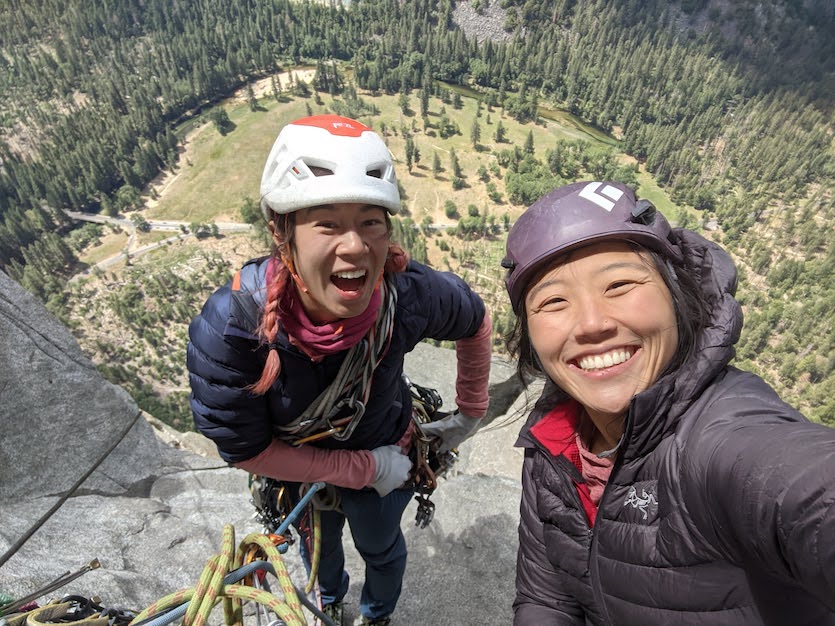
Cathie Yun and Julie Wang enjoyed climbing The Nose in four days. Photo by Julie Wang
Team Safety Survives
One by one, the pair negotiated well-known challenges like the Great Roof and Changing Corners pitches. They spent their nights comfortably on ledges, dining on pad thai and making video calls to friends. A few miscues, like a short fall, a dropped phone and “rope shenanigans,” caused no serious problems as they summitted in four days. Supporters welcomed them at the top with hot stir fry, pineapple and champagne.
Avoiding the near-death epics of the Allen and Kaufman parties, Yun and Wang enjoyed “the experience of a lifetime.” Perhaps their successful adventure best illustrates why people don’t just dream of climbing El Cap, and risk their necks trying, but actually enjoy it when they do.
El Cap has provided the author with some memorable moments, though I have less experience on the mountain than the others named in this article. After discovering Yosemite climbing in 1994, I enjoyed several short and moderate routes on the mountain’s base like Little John, La Cosita, and Moby Dick.
Naturally, I felt the mountain’s pull to climb higher, and the obvious place to start is on its easiest route. The East Buttress leads up 1,400 feet from the top of the large talus slope. Though it presents little difficulty to advanced climbers, the route was quite challenging for me. The first time I attempted it, I fell near the bottom and landed on a piece of gear, leaving a bruise on my hip that reminded me of my error for weeks.
Toes and Fingertips
Later I tried again with an English partner who I met in the climbers’ mecca of Camp 4. We hiked to the base in darkness and roped up at dawn. This time I climbed better on the chimney where I fell before. The third pitch provided the crux, ten feet of nearly featureless granite which climbers must ascend on toes and fingertips. Also memorable was a traverse high on the route which, though easier, risks a heart-stopping pendulum swing thousands of feet above the valley floor. We traded leads on a perfect summer day. Finishing that route felt great, demanded a celebration of pizza and beer in Curry Village and marked a highlight of my modest climbing career.
Part of me wants to climb something bigger, and though I’m now in my early 50s, I haven’t ruled it out. I’m not put off by the danger, even if I should be, which I regard as significant but acceptable.
In that regard, I seem to be in good company. Record-breaking climbers like Hans Florine and Emily Harrington both recovered from El Cap injuries and returned to climb the mountain again.
Another who bounced back is Becca Skinner, niece of free climbing pioneer Todd Skinner, who died in a 2006 rappelling accident. “I swore I would never climb again. However, six months after the accident, I was drawn back to the rocks,” she recalled. “Climbing will always be a part of who I am. It’s rooted in the depths of my soul.”
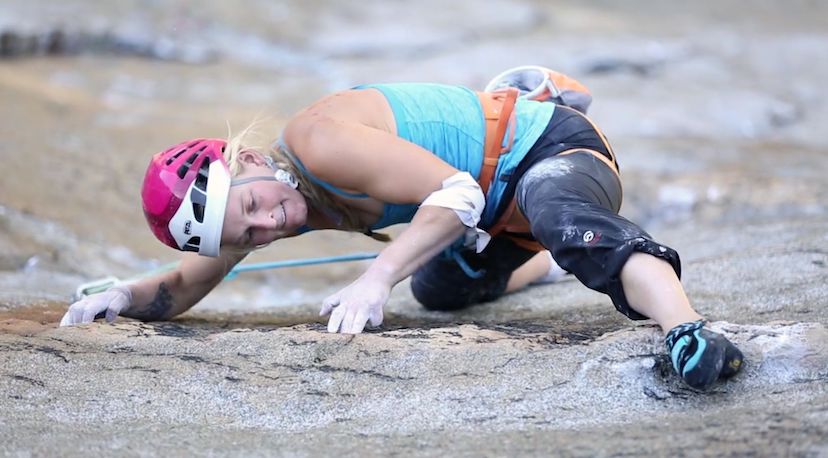
Emily Harrington climbs the Golden Gate route up El Capitan. Photo by Jon Glassberg
Should Children Climb Mountains?
Among the hundreds who summited El Capitan in 2022, a father and son duo gained the most attention. The pair relied on two guides to lead a four-day climb and anchor ropes which Joe Baker and his eight-year old son Sam ascended with jumars.
Some members of the climbing community criticized the decision to expose a child to such danger. Yet the elated Bakers seemed unmoved.
“It feels like we’re above eternity up here,” said Joe.
“It was awesome and I’m the youngest to do it,” said Sam. “In a few years, I’m going to come back and free climb it.”![]()
California native Matt Johanson enjoys hiking, skiing and writing about the outdoors. His books include Yosemite Epics: Tales of Adventure from America’s Greatest Playground and Yosemite Adventures: 50 Spectacular Hikes, Climbs, and Winter Treks. You can find more of his writing at mattjohanson.com.

